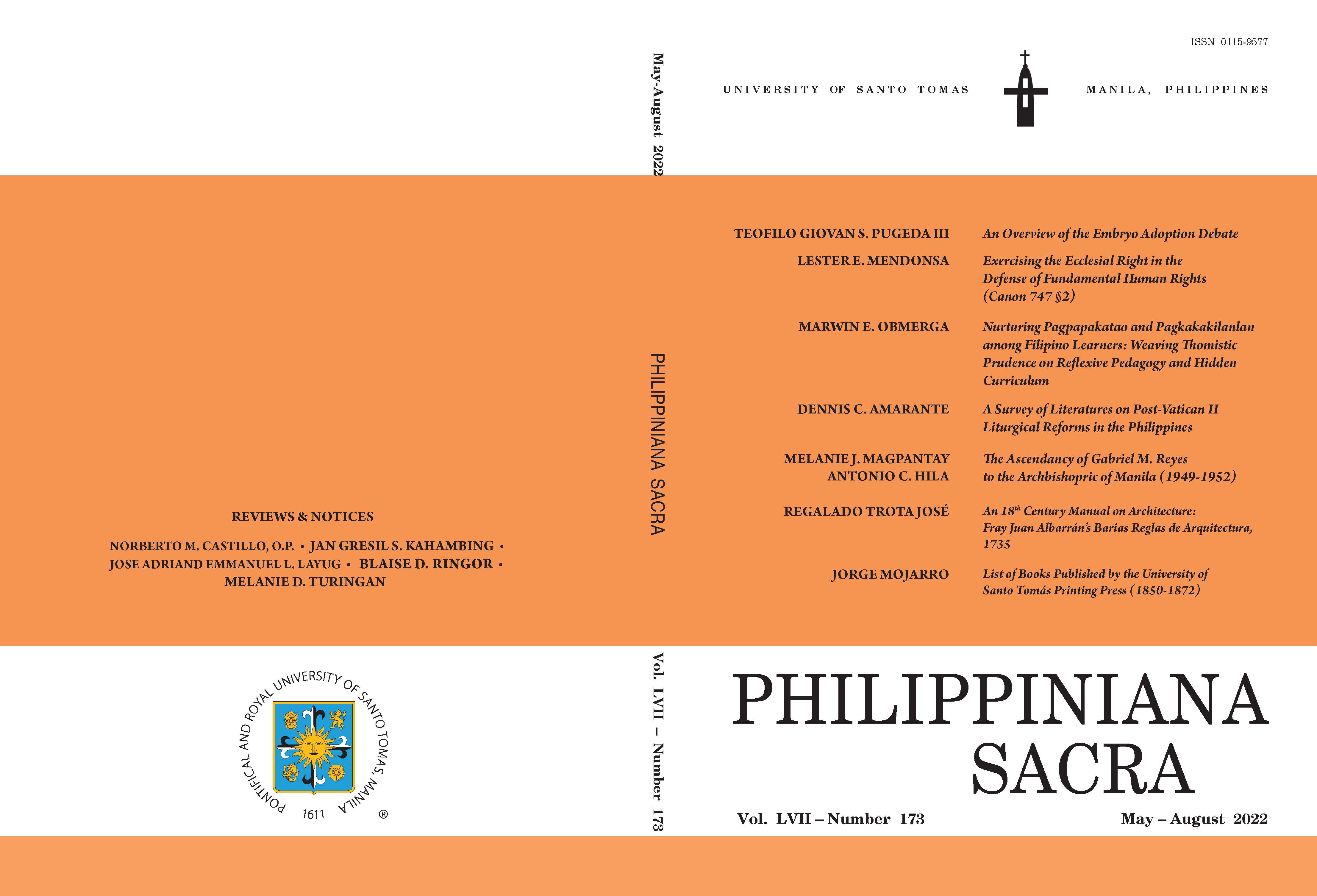-
DOI :
-
https://doi.org/10.55997/2001pslvii173a1
-
Author/s :
-
Teofilo Giovan S. Pugeda, III
Abstract :
In vitro fertilization (IVF) is opposed by the Catholic Church because it replaces the conjugal act. However, IVF has resulted in an ethical issue that the Catholic Church does not have a clear position on. What to do with the undesired cryopreserved embryos resulting from the IVF process? The Congregation for the Doctrine of the Faith, in its 2008 instruction on certain bioethical questions Dignitas Personae, commented on three proposals on what to do with them and stated that the situation for abandoned embryos “cannot be resolved.” But what about those not abandoned but undesired? Even before the issuance of Dignitas Personae, a debate developed regarding the third proposal of embryo adoption, which continues unresolved. We will explore the embryo adoption debate from 2007-2018 through the arguments of fifteen authors, with eight of them arguing not in favor of it and seven arguing in favor.
Keywords : assisted reproductive technology, Dignitas Personae, Donum Vitae, embryo adoption, in vitro fertilization, sexual ethics
-
DOI :
-
https://doi.org/10.55997/2002pslvii173a2
-
Author/s :
-
Lester E. Mendonsa, JCD
Abstract :
The Catholic Church enjoys the right to proclaim moral principles even in the social order and to defend fundamental human rights at all times (c. 747 §2). The papal prayer intention of April 2021 once again brings to the fore, the ecclesial right to safeguard human rights, those that have been agreed upon within the Universal Declaration of Human Rights but continue to be violated. The article examines the social and ecclesial implications that are inherent in the exercise of the ecclesial right. This includes the participatory role of every level of ecclesial governance from the papal magisterium to the lay faithful to promote and defend fundamental human rights, and to denounce violations to human dignity and values. The text presents three pastoral indications in accordance with the norm of law and magisterial teachings, to promote the ecclesial right to protect human rights.
Keywords : Ecclesial Right, Fundamental human rights, Promote, Defend, Violations
-
DOI :
-
https://doi.org/10.55997/2003pslvii173a3
-
Author/s :
-
Marwin Elarco Obmerga
Abstract :
The utilization of various forms of pedagogy has been accentuated far and wide as a significant component of the educative process and student formation. However, the exclusive exercise of traditional pedagogy in the classroom has been widely criticized since it is geared to produce would-be theoretical and technical specialists who cannot confront the ethico-moral forces of their undertakings. Today, more than ever, prior studies have repeatedly typified that a greater emphasis must be accorded to morally inclined and culturally sensitive pedagogies. This article attempts (1) to portray how educators can anchor on the precepts of Thomistic Prudence to cultivate the Pagpapakatao (Humanity) and Pagkakakilanlan (Identity) of learners through the exercise of Reflexive Pedagogy and Hidden Curriculum in the classroom; and (2) to provide an insightful characterization as to how the Filipino philosophical lens and cultural configuration will come into play as the educators attempt to carry out the Western educational modalities in a collectivistic society such as the Philippines.
Keywords : Thomistic Prudence, Reflexive Pedagogy, Hidden Curriculum, Filipino Culture, Humanity, Identity
-
DOI :
-
https://doi.org/10.55997/2004pslvii173a4
-
Author/s :
-
Dennis C. Amarante
Abstract :
Over the past decades, numerous studies by both Filipino and foreign scholars have been made on the history of the Church in the Philippines. Such studies will continue to appear especially that the Church in the Philippines had already undergone various historic milestones and events, beginning in the latter part of the 20th century, most notably those that occurred after the convocation of the Second Vatican Council. The convocation of Vatican II and the events that occurred as a result of it alone has opened an opportunity for scholars to study the various effects of the Council’s reforms in the Philippine context, including those that concern the liturgy or the very act of worship to God. Such led to the creation of works which attempted to understand how the Church in the Philippines implemented these reforms and how it affected the way Filipino Catholics worship over time. These works are highlighted in this study. This study aims to make a survey of some of the presently available works written by researchers, which include monographs, articles, and unpublished works, concerning the implementation of the Vatican II liturgical reforms by the Church in the Philippines and its effects on the way Filipino Catholics worship today.
Keywords : Church in the Philippines, liturgical reforms, liturgy, Philippine Church history, Sacrosanctum Concilium, Second Vatican Council
-
DOI :
-
https://doi.org/10.55997/2005pslvii173a5
-
Author/s :
-
Melanie J. Magpantay & Antonio C. Hila, PhD
Abstract :
This research will discuss, narrate, and analyze the factors that led to the appointment of the first native Archbishop of Manila and how he responded to the challenges of making the faith timely for the laity during his three-year stewardship guided by Arnold Toynbee’s Challenge and Response theory applied on the micro level. The seat of the Archbishopric of the Archdiocese of Manila was regarded as the premier office to be occupied by any clergy in the Philippines. For almost four centuries, this prime seat was given to foreigners, dominated by the Spaniards. Political and religious factors determined the archbishop-to-be: the patronato real during the Spanish era and the preference of the American officials during the American period. The choice for the episcopal seat took a paradigm shift after the codification of the Canon Law in 1917 when the appointment for the episcopacy rested solely on the Pope’s decision based on the candidate’s credentials. The same Canon Law was in effect on 1949 when the Archdiocese of Manila had its first native Coadjutor-Archbishop. The native clergy who was the designated successor of the ailing Archbishop Michael O’Doherty was Gabriel M. Reyes, an Aklanon, formerly of the Archdiocese of Cebu.
Keywords : Philippine church history, challenge and response, Filipinization, Post-war Philippines, Archbishops of Manila, RCAM



